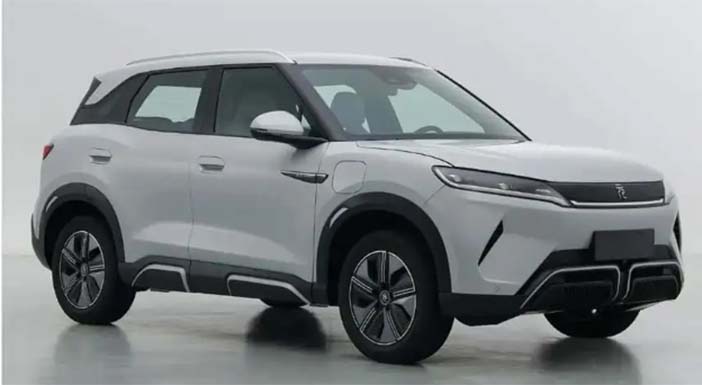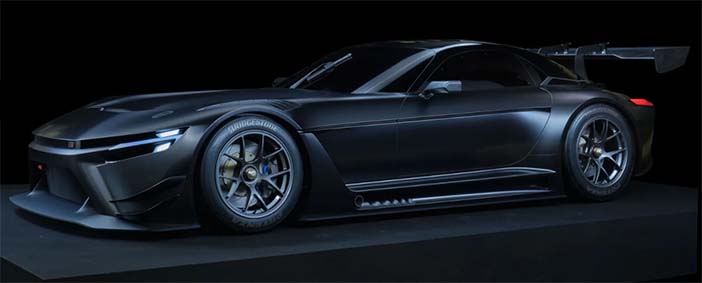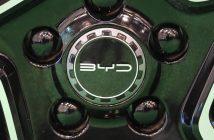+++ AUDI has almost every SUV base covered, except one. Its lineup tops out with the Q7, a 3-row family off-roader that squares up to the BMW X5 and Mercedes GLE. But both of those rival firms have even bigger SUVs to satisfy space-hungry American and Chinese buyers in the X7 and GLS, and so Audi has finally responded with the Q9. Compared with the Q7, the Q9 will offer even more space, and a greater emphasis on luxury, just as customers will expect when they’re potentially spending €150.000 on a new SUV. It will also offer more road presence through a combination of its sheer size, bulk and a distinctive front-end treatment that combines a huge main grille, large transverse lower grille and a split-headlight arrangement. The Q9 will get a rather formal, upright rear styling, though it’s possible Audi could also offer a companion Sportback model with a more coupe-like design. I know the Q9 will be launched before 2026, because that’s Audi’s self-imposed cut-off for switching over to electric power. It will still sell existing combustion-powered vehicles beyond that date, but all new models launched from that point will be EVs. To help customers navigate the list of the company’s EV and petrol models, it’s giving electric cars even numbers and combustion versions odd numbers, which is why the current A4 is being replaced by an A5, and why this flagship SUV is set to get the Q9 name. I’re expecting Audi to offer a mix of mild-hybrid and plug-in hybrid engines that hopefully still include a 4.0-liter V8 option to compete with the M- and Alpina-branded variants of the X7, though the trend in the industry is definitely one away from V8s and towards 6-cylinder engines instead. Another trend is towards PHEVs with usefully long electric driving ranges, so we imagine a plug-in Q9 should be capable of more than 110 km before needing a charge. The Q9 is likely to debut in 2025 for the 2026 model year, a timeframe that would enable it to last a full model cycle (with a facelift somewhere along the way) before Audi phases combustion products out of its lineup altogether in 2033. +++
+++ The new BYD ATTO 2 , a small value-focused electric car aimed at the Fiat 600e, has been revealed in Chinese homologation filings ahead of its launch later this year. To be sold under the Yuan Up name in China, the new front-wheel-drive electric SUV is based on BYD’s new third-generation electric car platform (the e-Platform 3.0, as it is known) and will fill the gap between the brand’s Dolphin and Atto 3. BYD hints it will begin sales in Europe in both left- and right-hand-drive specifications in 2025, but has given no specific timeframe. It has also yet to outline any pricing plans, but its positioning suggests the car would be priced at around €34.500 in the Netherlands. As well as the baby Jeep, it will compete with the new Mini Aceman and upcoming Smart #5; the latter (a SUV) also set to be unveiled in 2024 ahead of a European launch early next year. Another model targeted by the Atto 2 is the Volkswagen ID.2X; a compact SUV planned for global sale in 2026 as a replacement for today’s combustion-engined T-Cross. BYD has yet to provide any official technical details of the new 5-seater. However, information published by China’s Ministry of Industry and Information Technology reveals it measures 4.310 mm long, 1.830 mm wide and 1.675 mm tall, making it slightly smaller than the Atto 3. The regulatory information also reveals the Atto 2 will receive a front-mounted electric motor with either 95 hp or 150 hp; a specification similar to the Dolphin. It is powered by the Chinese carmaker’s own lithium-iron-phosphate Blade battery, with a capacity of 45.1 kWh for a range of 400 kmiles on China’s optimistic CLTC test cycle. The kerb weight for the new BYD model is put at 1.540 kg. Final details remain under wraps as BYD completes late-stage testing ahead of a reveal in the coming weeks. +++

+++ HONDA has issued a service bulletin for the ZR-V crossover after multiple reports from customers that the rear windows have shattered without warning. This news comes to us by way of Consumer Reports (CR), who happened to experience the problem first-hand with one of their own test vehicles during a winter weather warm-up. The good news is that Honda has identified the cause. If not applied just so, the sealer that holds the window in place can come in contact with the heating element for the rear defroster. This hot spot can lead to fatigue over time. If it weakens enough, it may fail, taking the entire rear window with it. Per Honda’s report to NHTSA, at least 300 customers have complained of shattered rear windscreens. “Nobody was injured, and the cargo in the rear wasn’t damaged”, CR said of the incident. “But our tester had to clean up glass shards from his driveway, and the contents of the cargo area were no longer secure from weather and theft”. Honda says it will inspect customer ZR-Vs and replace the glass for free if a defect is found, but has stopped short of initiating a safety recall. Why? While the glass shattering could alarm an occupant, Honda says there’s no inherent safety threat posed by the problem and Honda even says owners should continue to use their rear defrosters as needed. Dealers should be prepared to handle replacement requests starting in April. +++
+++ A smaller version of the MERCEDES G-CLASS will be electric-only when it launches later in the decade. The model will be developed by Mercedes’ new specialist G division as the third model in an expanded G range, after the upcoming Mercedes EQG. Mercedes technical chief Markus Schäfer confirmed the powertrain plans at the recent CES in Las Vegas, dismissing suggestions that the model could also be offered with hybridised internal combustion engines. The model was first confirmed by company CEO Ola Källenius at the Munich motor show, where he referred to it as the “little G… a son or daughter of the iconic big G”. Mercedes-Benz design chief Gorden Wagener told that the new machine will take strong design cues from the “iconic DNA” of the existing G-Class, saying: “It will have its own character, but it will be a G”. The G-Class line-up will expand first later this year with the new electric Mercedes EQG, and Autointernationaal.nl understands the new ‘little G’ will follow in 2026. Mercedes has launched a new Mercedes Modular Architecture (MMA) that will be used for a range of entry-level cars in the coming years, starting with the new Mercedes-Benz CLA, but Schäfer confirmed that the ‘little G’ will sit on a different platform, using modules from Mercedes’ larger rear-driven cars, due to its need to offer true off-roading ability. That means the platform will be different (but likely to take learnings from) that of the full-sized EQG, which will use a reworked version of the existing ICE G-Class’s ladder-frame chassis and will be powered by 4 electric motors. As well as giving Mercedes a foothold in the increasingly popular rugged crossover market, the baby G-Class will be crucial in establishing G as a Mercedes sub-brand in the same vein as Maybach and AMG, building on the success of its blocky Land Rover Defender rival. Indeed, G is now its own specialist division within Mercedes, just like Maybach and AMG. Källenius said last year: “Most luxury companies build their portfolio on the basis of one or two true icons. Mercedes-Benz has the good fortune to have multiple iconic products and brands at the upper end of its portfolio, such as the S-Class, the SL, the G-Class as well as the AMG and Maybach brands. “We see great potential here to expand our top-end portfolio with even more fascinating products”. His comments hint at the possibility for each of those four brands to spawn more comprehensive line-ups. Like the upcoming CLA, the new compact SUV is likely to have an 800 Volt electrical architecture, allowing for 400 km of range to be added in just 15 minutes via a 250 kW charger. It is likely also to be fitted with a new type of electric motor developed and produced in-house and making its debut in the CLA. In that compact saloon, outputs will range from 204 hp in the entry-level rear-wheel-drive variant up to a 550 hp in a dual-motor AMG model. The baby G-Class is expected to follow the CLA in offering a choice of lithium-iron-phosphate (LFP) and lithium-nickel-manganese-cobal
+++ While RENAULT seeks to secure its footing in the value-focused B-segment, the company is also investing heavily in expanding its offering in the larger and more expensive C-segment, and as part of that, it will launch a new SUV to rival the likes of the Toyota C-HR. The new crossover is understood to be only slightly larger than the Clio-based Captur, at around 4.400 mm long, and positioned to fill the gap between that car and the coupé-backed Arkana. It will effectively straddle the boundary between Renault’s small B-segment line-up and the larger Arkana, Austral and Rafale SUVs. Product performance boss Bruno Vanel explained why Renault is expanding its line-up in this area: “We were a lot focused on the B-segment, maybe a little bit too much, whereas the European market is at least as much focused on the C-segment. “What we did is balance our focus a little bit more between the C- and B-segment, and from less than 25% of our sales being C-segment, we have almost reached 40% in recent months”. Due in 2024, the as-yet-unnamed C-HR rival will likely be based on the same CMF-B architecture as the Captur. That would enable it to offer the same choice of full- and plugin hybrid powertrains while potentially paving the way for a pure-electric derivative further down the line, based on CMF-BEV (now known as Ampr Small). Vanel said introducing a car in this space would be emblematic of the brand’s push for higher margins with a new target demographic: “We are going for it with the Rafale and the Espace. These are sort of new areas for us, these kinds of SUVs”. He added that “higher turnover is important for us, maybe also with some more affluent customers sometimes”, but Renault does “not want to lose” its traditional customer base. “We are not aiming at being premium”, said Vanel. “I would say being at the top of what you call the mainstream, but a little bit more at the top than at the bottom, for sure”. +++
+++ SUBARU has published pricing information and specifications for the 2024 model year Solterra. The electric crossover gets a handful of new features, including faster charging and additional driving aids, and it remains available in three trim levels and costs about as much as it did for 2023. You can count the changes that Subaru made to the Solterra, its first series-produced electric car, on one hand, but they should add up to a more convenient driving experience. Sit in the driver’s seat and you’ll face a redesigned steering wheel that’s no longer oval and that’s fitted with paddles used to control the regenerative braking system. Instead of shifting up a gear, the paddle labeled “+” dials in more regeneration. The “-” paddle selects a less aggressive regeneration profile. When your battery gets low, topping it up should take less time. Subaru promises that charging from 10% to 80% now takes approximately 35 minutes, though a variety of factors (including the ambient temperature) can affect that number. The estimated charging time remaining appears next to the state-of-charge indicator. Speaking of the weather, Subaru also notes that the 2024 Solterra charges “up to 80 minutes faster in certain conditions” than the 2023 model in sub-freezing temperatures thanks to improvements made to the conditioning system. Once you’re back on the road, you can count on new features added to Subaru’s EyeSight suite of electronic driving aids to keep you and yours safe. The 2024 Solterra is capable of traveling in its lane with only driver supervision at up to 40 kph, even in traffic. The driver can also ask the car to change lanes on its own by signaling, and every 2024 Solterra comes standard with Front Cross Traffic Alert technology. Finally, the list of standard features now includes a pair of roof rails capable of carrying up to 300 kilos. Subaru hasn’t made changes to the specifications sheet. Power for the 2024 Solterra comes from a pair of electric motors (one per axle) that draw electricity from a 72.8 kWh lithium-ion battery pack to zap the 4 wheels with 218 horsepower and 337 Nm of torque. Driving range checks in at about 460 km. +++
+++ Who would’ve guessed that in 2024, TOYOTA would be the company churning out a wide variety of performance cars? Once considered the epitome of A-to-B commuter devices, Toyota now has several exciting cars under its Gazoo Racing banner, and a new trademark filing could mean yet another. AutoGuide unearthed Toyota’s filing for the GR GT trademark with the European Union Intellectual Property Office. The “GT” moniker, usually reserved for elite performance models, immediately fueled speculation that it would be for a range-topping track weapon. A super-Supra sports car, if you will. The obvious candidate would be the street-legal version of Toyota’s GT3-class race car. We’ve already seen patent renderings of it and an actual concept. The car was originally scheduled for a debut in the 2025 World Endurance Championship season, but last summer the team director said that the race car was being delayed one year to align with the production car’s launch in 2026. WEC homologation rules stipulate that 300 road cars must be built in order for the race car to compete. There was some question of whether the car would be branded a Toyota or a Lexus. The team believed at the time that the powers that be were leaning toward Lexus. The appearance of the GR GT trademark could mean that the decision makers have changed course and that the GT3 racer will be a Toyota. Or it could mean both Lexus and Toyota will each get a version. But given that Lexus is trying to go all-electric, the Toyota branding makes more sense. Also, we would be remiss if we didn’t mention the GT3 concept’s uncanny resemblance to the Mazda RX-Vision. We know Toyota is fond of partnering with other carmakers to build sports cars and Toyota owns 5% of Mazda. Do with that information what you will. No matter what it’s named, a camouflaged version of the car has already been spotted testing at Fuji Speedway in central Japan. With the GR86, GR Yaris, GR Corolla and GR Supra already on the docket, as wells cars like the IS 500, RC F and LC 500 in the Lexus stable, Toyota is an unlikely manufacturer committed to keeping enthusiasts’ cars alive. +++




